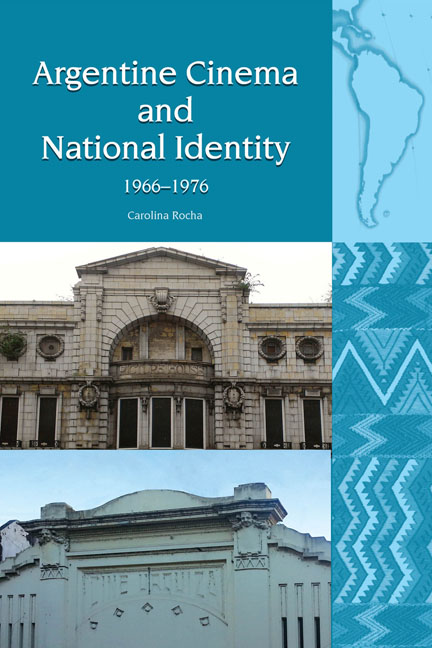Book contents
- Frontmatter
- In Memory of Paulina Piselli (1937–2017)
- Contents
- Acknowledgements
- Introduction
- Section I Argentine History and National Cinema, 1955–1976
- 1 Political and Social Tensions in Post-1955 Argentina
- 2 Argentine Cinema in the Late 1950s and Early 1960s
- 3 Argentine Cinema, 1966–1973
- 4 Argentine Cinema, 1973–1976
- Section II The Cinematic Gauchesque
- Section III Representing Founding Fathers
- Conclusion
- Bibliography
- Index
1 - Political and Social Tensions in Post-1955 Argentina
from Section I - Argentine History and National Cinema, 1955–1976
- Frontmatter
- In Memory of Paulina Piselli (1937–2017)
- Contents
- Acknowledgements
- Introduction
- Section I Argentine History and National Cinema, 1955–1976
- 1 Political and Social Tensions in Post-1955 Argentina
- 2 Argentine Cinema in the Late 1950s and Early 1960s
- 3 Argentine Cinema, 1966–1973
- 4 Argentine Cinema, 1973–1976
- Section II The Cinematic Gauchesque
- Section III Representing Founding Fathers
- Conclusion
- Bibliography
- Index
Summary
To understand the political events of the decade 1966–1976, it is crucial to consider the coup d’état that ousted Perón and established the Revolución libertadora. In September 1955, a rebellion against the military leader was instigated by a coalition of Catholics, the urban middle classes, and the two different factions of the armed forces. General Eduardo Lonardi (1896–1956), who proclaimed the mantra ‘neither victors nor vanquished’ and was briefly in power until November of that year, led the more conciliatory of the military factions. The other, profoundly anti-Peronist, soon displaced Lonardi, ‘accusing him of complicity with the nacionalistas and of tolerating Peronism and workers’ movements’ (Senkman, 1984, 121). Both groups, however, blamed Peronists for being anti-nationalist, corrupt, and inefficient (Spinelli, 2005, 30). The armed forces that took over the country's leadership sought to revert to the ‘true’ national being, particularly enforcing—albeit not immediately—the rights listed in the Argentine Constitution and hoping to unite groups as diverse as unionists, anti-peronists, and liberals.
The Revolución libertadora held that Peronism threatened the country's true core values, and so a new vision was needed for Argentina. The Peronist national identity revolved around the perpetuation of the welfare state that had heavily benefitted the working class, integrating its members into the body politic as citizens. Nonetheless, the conditions that allowed the emergence of such a state post-Second World War—namely the demand for agricultural products and import-substitution industrialization—could no longer sustain domestic capitalist growth, and thus changes in the Peronist version of the Argentine national identity were also needed. Here it is important to take into account Jorge Larraín's insight that ‘for identity to become an issue, a period of instability and crisis, a threat to old-established ways, seems to be required’ (2000, 8). While the crisis of Peronism ushered in the Revolución libertadora, Perón's power—even in exile—as protector of the working-class masses, profoundly affected the mission of the ‘revolutionary’ government and its attempt to propose a new version of national identity. The working class's loyalty to Perón and his postulates contributed to making him a constant referent in Argentine political life, a dynamic that further complicated the process of legitimating the nationalism of anti-Peronists, and also upset the role and viability of political parties, such as the Unión Cívica Radical (UCR) and the Socialist and Communist Party.
- Type
- Chapter
- Information
- Argentine Cinema and National Identity (1966–1976) , pp. 16 - 26Publisher: Liverpool University PressPrint publication year: 2018



